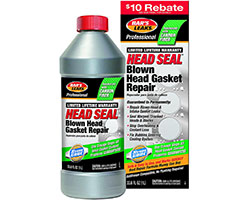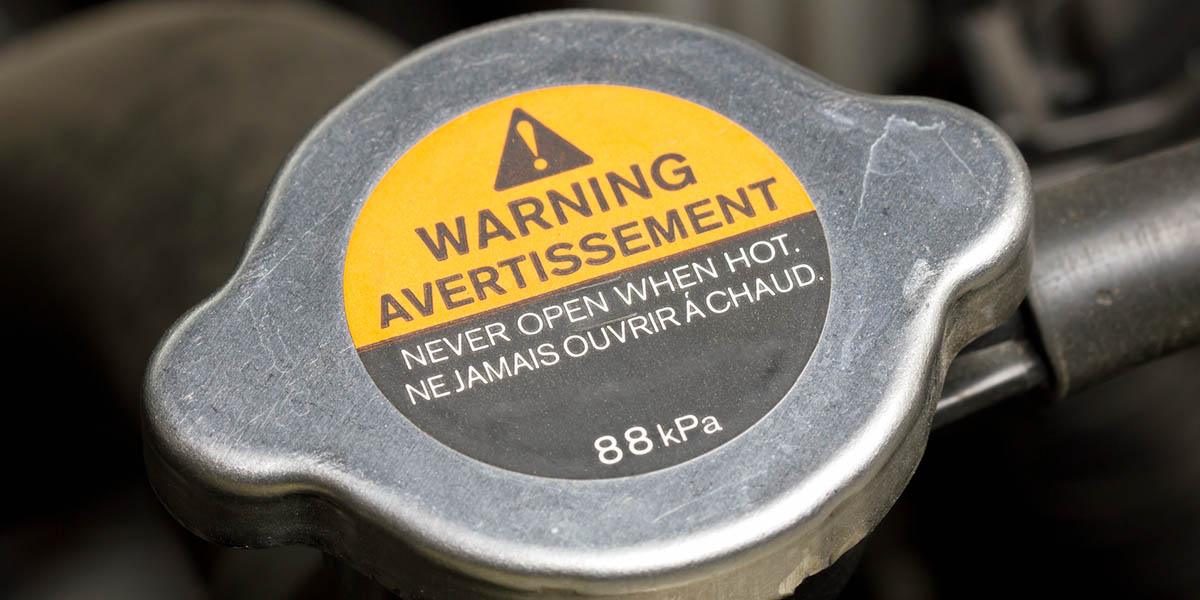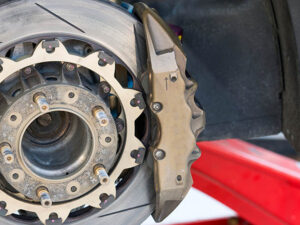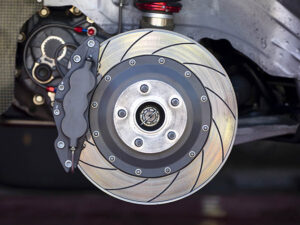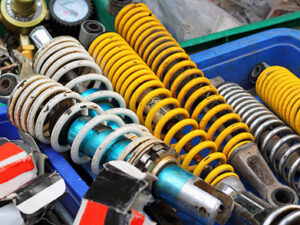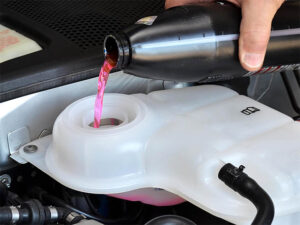Home \ Shop \ Engine & Efficiency \ Head Gasket Sealers
The Best Head Gasket Sealers – 2025 Review and Buyer’s Guide
Blown head gasket? There is temporary action to solve this problem quickly, so the car will perform well after proper applying the best head gasket sealer
- 1. Why do Engine Head Gaskets Leak?
- 2. Review Of The Best Head Gasket Sealers
- 3. BlueDevil Head Gasket Sealer with Radiator Flush
- 4. Bar's Leak HG-1-4PK HEAD SEAL
- 5. J-B Weld Ultimate Copper Silicone Gasket Maker
- 6. K-Seal HD Coolant Leak Repair (ST5516)
- 7. K&W FiberLock Head Gasket & Block Repair (401224)
- 8. How to Spot a Leaking Engine Head Gasket?
- 9. Key Features of the Best Types of Head Gasket Sealer
- 10. Other Important Features to Consider When Shopping for Head Gasket Sealers
- 11. How to Correctly Use Head Gasket Sealer?
- 12. Can the head gasket sealer damage the engine?
- 13. How long will head gasket sealer last after applying?
- 14. Complete gasket replacement vs. head gasket sealer?
- 15. Can head gasket sealer eventually also clog larger holes?
- 16. How long can you drive with a blown head gasket?
We’ve all heard the phrase, “blown cylinder head gasket”, but nothing in those four words fully describes the nightmare a failed or failing cylinder head gasket can visit on a car owner. Not only is the vehicle likely to overheat – or even catch fire, as was the case with many Ford Kugas – and leave the owner stranded, the repair can be expensive. At best a gasket replacement will cost between $1500 and $3000, at worst the engine may have to be overhauled or replaced. All of which means the vehicle will be off-road for an extended period.
Fortunately, thanks to the advent of head gasket sealers, not every leaking cylinder head gasket is going to be a nightmare. For less serious gasket leaks, where the engine can run for longer than about 20 minutes before overheating, the best head gasket sealers offer a cost-effective and convenient solution to what would normally require a costly trip to a repair shop.
Why do Engine Head Gaskets Leak?
With engine head gaskets subjected to severe stress caused by massive changes in temperature, high thermal gradients and cylinder pressures, leaks are not that uncommon. These are typically caused by:
The head gasket has reached the end of its life
As described above, an engine head gasket operates in continually changing and harsh conditions, which unfortunately limits its lifespan. The time to failure is largely influenced by adverse operating conditions:
- To achieve an optimal lifespan it is best to let the engine get up to operating temperature before demanding high engine speeds or laboring the engine in too low a gear.
- Make sure the coolant reservoir is always topped up, to reduce the chances of the engine running hot.
- Make sure the airflow through the radiator is not obstructed.
Engine overheating
Overheating is often the result of:
- A failed or leaking water pump.
- Insufficient antifreeze added to the system’s water.
- Loss of coolant through a leaking radiator hose or radiator-core. These leaks can often be repaired, using a sealant similar to the head gasket sealant – radiator stop-leak.
Pre-ignition
Often referred to as “engine knock”, the spikes in temperature and cylinder pressure triggered by the fuel’s violent detonation, if left uncorrected, can cause the head gasket to fail.
Warped cylinder head
This is either caused by a previous overheating event or an incorrectly torqued (tightened) engine head.
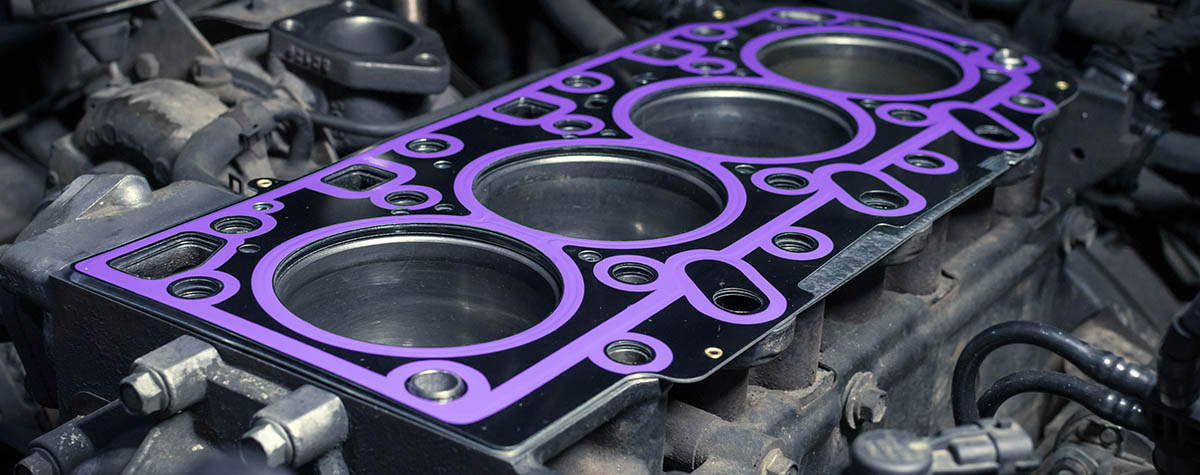
Review Of The Best Head Gasket Sealers
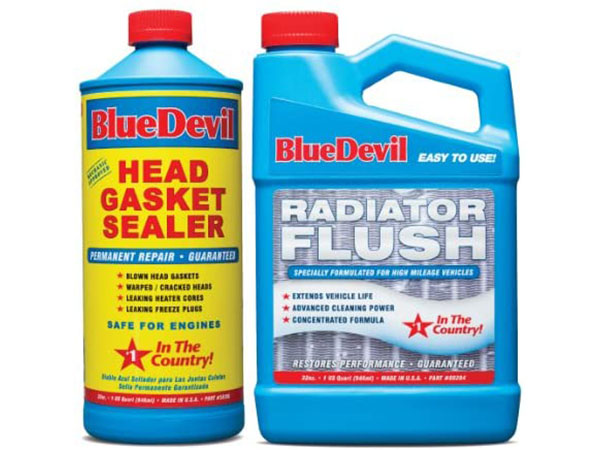
PROS
- This sealant offers a permanent solution that doesn’t rely on solid particulates to stop leaks
- One treatment is capable of repairing leaks anywhere in the coolant system
- A well respected brand manufactured by a reputable company
CONS
- Requires the removal of the thermostat before treatment. In rare cases it may block tubes in the radiator or heater core
MAIN CHARACTERISTICS
BRAND
BlueDevil ProductsMODEL
38386 / 00204WEIGHT
5.45 lbPRICE RANGE
$65
Are you looking for a head gasket sealer that permanently repairs a leaking head gasket? Do you also have a leaking radiator? So that means you have to buy two products to fix two problems – right? Not if you opt for Blue Devil Engine and Cooling Sealant that not only permanently seals cracked or warped heads and most blown head gaskets but also has the incredible ability to cure leaking Walsh plugs, radiators and heater cores. The sealer doesn’t rely on the solid or particulate matter to temporarily stop the leak: Instead, it bonds directly to metal, aluminum, cast, alloy and plastic, to permanently repair the leak. This safe and easy to use head gasket sealer works equally well on cars, trucks, vans and SUV’s with gasoline or diesel engines. And as an added bonus Blue Devil Engine and Cooling Sealant comes bundled with Radiator Flush to clean the coolant system for the best results.
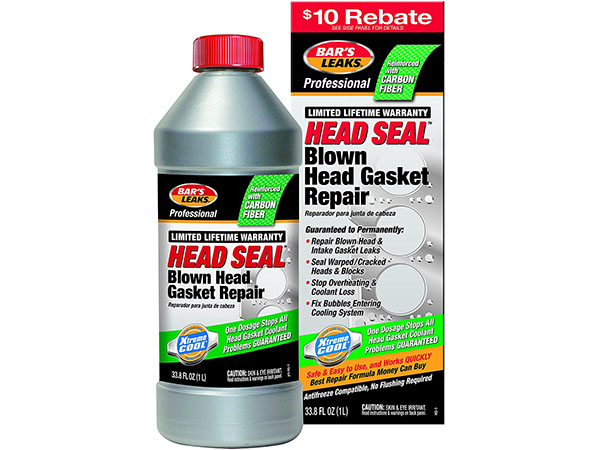
PROS
- The sealant is a permanent solution that can stop significant leaks that most other products can’t
- One bottle treats cooling systems from 2.5 to 5 gallons. Half a bottle will treat systems of 1.5 to 2.49 gallons
- This product is produced by a well-respected U.S.-based Company with its first head gasket-leak repair patent dating back to 1950
CONS
- Like many other liquid formulations this gasket sealer could clog the heater core or radiator if there is an existing partial blockage
- The formula’s high viscosity makes it quite difficult to pour into the radiator
MAIN CHARACTERISTICS
BRAND
Bar's LeaksMODEL
HG-1-4PKWEIGHT
2.5 lbPRICE RANGE
$149
There was a time when a blown head gasket would see you having to layout between $1,500 and $3,000 to get your car back on the road. But that was before the advent of Bar’s Leaks Blown Head Gasket sealer. This professional-grade sealer, that is antifreeze compatible, repairs leaking or damaged engine head gaskets using a sodium silicate sealing liquid in combination with other gasket-sealing compounds to plug the leak. The seal thus formed is also stronger than the original head gasket. Not only will it fix a blown head gasket, but it can stop all other coolant leaks in plastic, cast iron, copper and aluminum radiators, heater cores, freeze plugs, gaskets, intake manifolds, cylinder heads and engine blocks. What’s more, the high-strength carbon fibers serve the same function as rebar in reinforced concrete when stopping larger leaks and permanently sealing any seepage. Meant to be a comprehensive coolant-system treatment, the advanced formula also contains Xtreme Cool, an additive developed to lower peak coolant temperatures and prevent overheating.
PROS
- The sealer can withstand continuous temperatures of 550º F or intermittently up to 650º F
- The RTV remains pliable across the full range of operating temperatures
- It is versatile and can also be used for high temperature applications around the home
- The product cures in about one hour
- JB-Weld is a well-known company with over 40 years’ experience in producing sealers
CONS
- Although not directly related to the product’s functionality, the tubes containing the sealer are not particularly rugged and tend to break open with repeated use
MAIN CHARACTERISTICS
BRAND
J-B WeldMODEL
32325WEIGHT
3 ozPRICE RANGE
$10
Gone are the days when you had to painstakingly manufacture your own gaskets from cork or vellumoid: using J-B Weld’s Ultimate Copper High Temperature RTV Silicone Gasket Maker and Sealant – a general purpose room temperature vulcanized silicone – you can now simply apply a gasket to most surfaces. Specifically formulated to seal and bond uneven planes, the silicone forms a tough, waterproof seal on most surfaces. What sets this gasket-maker apart from other sealers is its ability to withstand the high temperatures and loads often found in automotive applications. Since the sealer remains flexible at temperatures up to 650º F it is ideally suited to making gaskets for engine covers, and even exhaust manifolds, that are subjected to elevated temperatures – these gaskets will never get hard or deteriorate over time. Yet, because the sealer will not shrink or crack and resists weathering once it has cured – which happens within about an hour when the product is exposed to the moisture in the air – it is also ideal for use around the home or securing automotive trim.
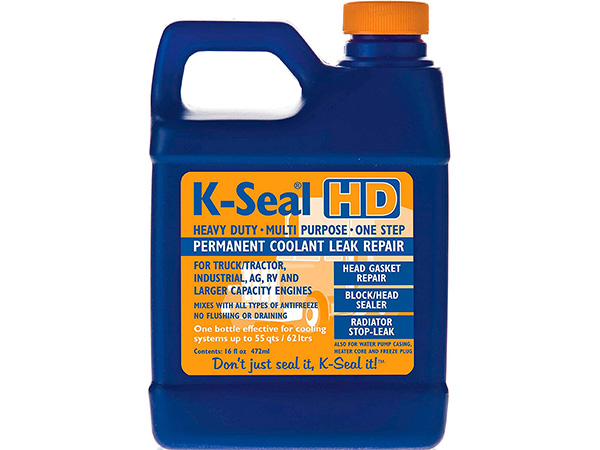
PROS
- A great solution for high-capacity engines
- Has a permanent repair effect of the minor cracks in the head gasket, engine block, and small leaks of all cooling system elements
- An easy-to-use solution: just shake, pour and go
- Compatible with all antifreeze types and coolant compounds, so it can be used without draining your current coolant
CONS
- This 16 fl oz package isn't designed for small cars, so use an 8 fl oz bottle instead
MAIN CHARACTERISTICS
BRAND
K-SealMODEL
ST5516WEIGHT
1.19 lbsPRICE RANGE
$22
This head gasket sealer is specially made for larger-capacity engines, with an overall coolant volume of up to 55 qts / 62 Liters. So, K-SEAL ST5516 is highly recommended if the vehicle type of which you care about problem-solving with coolant leakage is a truck, RV, bus or tractor, etc.
This product is very easy-to-use and to do this, you need to perform 2 easy steps. The first – is to shake the bottle for approximately 30 seconds. Secondly – you need simply pour the sealer into the expansion tank or radiator directly if the last has the cap. Take note, that this product does not require any coolant system or radiator flushes, antifreeze draining before pouring into the system.
What happens after you poured the K-SEAL ST5516 sealer into your car’s engine? The first thing you need to take into account is that the changes make sense after several minutes and even more than 10 minutes if you poured into the expansion tank. During this period, the sealer needs to become mixed with the coolant and perform any blocking of the potential crack or leak. The second thing – you need to heat up an engine to changes have sense. These easy-to-use features and overall customer satisfaction level are manifested in a total score of 4.3 out of 5 on Amazon.
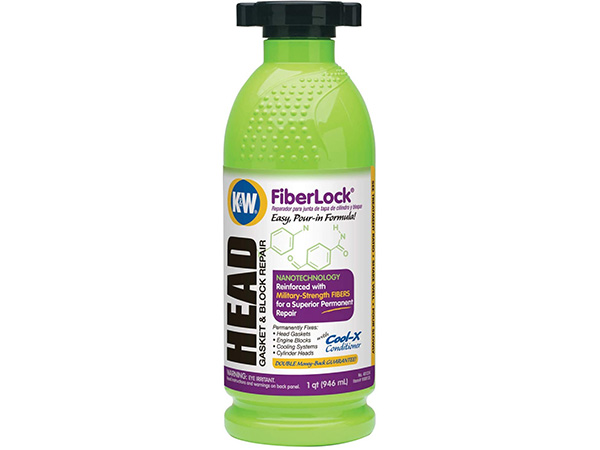
PROS
- Suitable for sealing larger holes with less fluid loss than analog products
- The outstanding 3-in-1 formula has an extra in form of high-technology fibers and conditioner containment to make the effect better
- This sealer requires to be only poured into the cooling system contour and it began to work
- The manufacturer, a well-known "CRC" company, offers a double money-back guarantee if this sealer will not work
CONS
- The same as all of the analog liquid engine head gasket sealers, this product might not work if there are clogged elements (like heater core, thermostat, radiator) inside of the cooling system
MAIN CHARACTERISTICS
BRAND
K&WMODEL
401224-6WEIGHT
2.5 lbsPRICE RANGE
$28
This K&W 401224 Head Gasket & Block Sealer with the FiberLock patented technology is a brand new product if you see it closer. Thanks to new technology, this sealer stands apart from the other ones. But this is not the last advantage and the consumer will have more if picked K&W 401224.
Besides the main feature, like unique nanotechnology reinforced by the military strength fibers, this product belongs to the “Pour&Go” category. You simply have to pour it out into the cooling system contour to start it working. Also, you can use it with any antifreeze or coolant that you have using currently, no need to drain it. Another step to be claimed to best head gasket sealer – is the containment of the conditioner into the overall 3-in-1 formula. Using it in this product makes the coolant operating temperatures lower compared to the referral values.
If you decide to buy this K&W Head Gasket Sealer – you might be satisfied. The overall rating on Amazon and passed test (ASTM D6107) in the proven laboratory – points to this.
How to Spot a Leaking Engine Head Gasket?
While some symptoms of a leaking cylinder head gasket are very obvious, others may be less so:
1. White smoke emitted from the exhaust pipe
White as opposed to blue or black smoke, commonly resulting from over-rich fuel mixtures, is a sure sign that the engine is burning oil. This is not necessarily due to a blown head gasket, but in conjunction with other symptoms should be a cause for concern.
2. Uneven idle or a misfire
As with the white smoke, this in itself is not a sure sign of a leaking gasket, but it is a reason to check for other symptoms that may point to a damaged gasket.
3. Engine oil appears milky
This is an indication that coolant is entering the cylinder through a damaged head gasket, finally mixing with the oil in the crankcase.
4. Air bubbles in the coolant bottle or radiator tank
A leaking gasket will allow gas from the combustion process to escape into the water jacket and surface in the coolant bottle.
5. Loss of coolant without signs of an external leak
While this is often an early warning of a leaking gasket it will eventually be accompanied by other symptoms, such as discolored engine oil and smoking.
6. The engine temperature gauge shows an abnormally high reading
While this shows that the engine is running hot, it is not necessarily because of a leaking cylinder head gasket: Check for other symptoms to confirm that the gasket is probably the culprit. It is important to note that once all the coolant has escaped, the temperature gauge will often indicate “cold”, as there is no hot coolant in contact with the probe.
Once you’ve confirmed a leaking cylinder head gasket to be the cause of the problem, you are faced with a choice: Carry out an expensive cylinder head gasket replacement, or shop around for the best head gasket sealer?
Key Features of the Best Types of Head Gasket Sealer
With so many products on the market, in this section of the guide, we will describe the key features that define the best types of head gasket sealers to rectify a blown or leaking cylinder head gasket. Not to be confused with gasket sealers, such as J-B Weld’s best priced 32325 Ultimate Copper High-Temperature RTV Silicone Gasket Maker and Sealant, which are used to make gaskets to seal everything from oil pans and water pumps to oven doors. Make no mistake, while these gasket sealers cannot be used to carry out a “stop leak” repair on a leaking cylinder head gasket, they are vital if the engine needs to be rebuilt.
- Long-lasting repair. Even though many view head gasket sealers as a temporary fix for a leaking or damaged gasket, the technology has progressed to the point where the best head gasket sealers are now seen as permanent solutions. Thus, if you’re looking for a long-lasting repair look for products containing sodium silicate (Na2SiO3) that when heated to about 220°F melt into a very thin, glass-like layer that produces a permanent seal. The sealer’s packaging may not refer specifically to sodium silicate, but will certainly spell out the long-lasting qualities of the product.
- Suitability across a wide range of applications. When comparing the key features of the best types of head gasket sealers it is important to make sure that the sealer is compatible with the type of engine you intend to use it on. Because of their higher cylinder pressures, some sealers may not work on diesel engines, or even be restricted for use on certain materials such as cast-iron or aluminum. It is therefore important that when searching for a sealer you select a product, such as Bar’s Leak HG-1-4PK head seal blown head gasket repair, that because of its versatility is widely heralded as a premium head gasket sealer. Not only is this product safe to use on gasoline or diesel engines and aluminum or cast iron but it is also suitable for use on vehicles with turbochargers.
Other Important Features to Consider When Shopping for Head Gasket Sealers
While the best head gasket sealers have been formulated specifically to stop water and oil leaking past damaged cylinder head gaskets, manufacturers continue to develop products that offer a wide range of added benefits that consumers should be aware of.
Versatility
There are products – such as BlueDevil’s best-in-class 32oz Head Gasket Sealer that comes with Radiator Flush – that are designed to perform many other tasks. For instance, BluDevil’s sealer can:
- Permanently seal leaking radiators and Welch plugs.
- Permanently seal leaking heater cores.
- Permanently stop leaks from warped and cracked cylinder heads.
- Permanently stop leaks from cracked engine blocks.
Sealer quantity
Even though the sealer is measured in ounces, it is common practice for manufacturers to indicate the size of the engine or the number of cylinders the sealer can successfully repair. With quantity usually ranging from 8 ounces to a few gallons you must make sure that there is sufficient product to successfully treat your specific vehicle.
Ease of use
When selecting a head gasket sealer read the instructions carefully so that you understand the scope of the work at hand, paying particular attention to:
- Make sure the product comes with a clear set of instructions.
- Is the product compatible with antifreeze coolants?
- Can the sealer be added to the radiator/ expansion bottle?
- Can the thermostat be left in place?
- Must the coolant be drained and refilled after the repair?
Time to cure
Most sealers have an activation time during which the vehicle cannot be driven. It is important that this is clearly laid out in the instructions. Most require about an hour, depending on the coolant system’s capacity.
How to Correctly Use Head Gasket Sealer?
Having established that your vehicle’s cylinder head gasket is damaged, and selected the best head gasket sealer for your circumstances it is time to effect the repair. The first place to start is with the instructions that come with the sealer. As products differ, it is always best to follow the manufacturer’s advice. While these instructions may differ in their detail the procedure should be similar.
- If the sealer cannot be added to a coolant containing antifreeze, drain the system and refill with water, making sure to bleed the system if required.
- If the sealer can be added to a coolant containing antifreeze, skip this step.
- Some manufacturers may also recommend you remove the thermostat – check the product’s instructions.
- Shake the head gasket sealer container to agitate the contents.
- Add the prescribed amount of sealer to match the coolant system’s capacity. Ideally, this should be added directly to the radiator, but if that’s not possible, add it to the expansion bottle.
- Make sure the coolant level is correct, as per the vehicle’s handbook.
- Start the engine.
- Set the climate- or heater temperature-control to the maximum.
- Increase the engine speed to about 1000 RPM and keep it there for at least 15 minutes.
- Switch off the engine and let the sealer cure for at least one hour (Or the time recommended in the product’s instructions) before using the vehicle.
- Once the sealer has cured, start the car and bring the engine up to operating temperature before taking the vehicle for a test drive.
- During the drive keep an eye on the temperature gauge to make sure the overheating has been cured.
If the engine runs normally without overheating or losing fluids it means your head gasket sealer has done its job.
Using the best engine head gasket sealer to fix a leaking gasket might sound a little daunting to the novice DIY enthusiast, but armed with this guide a successful repair can be carried out with confidence. Saving time and money along the way.
Can the head gasket sealer damage the engine?
Using one of the quality head gasket sealers recommended in this guide, and following the manufacturer’s instructions, will cause no harm to the engine. However, using a poor quality product or not following instructions could result in blockage of the coolant system and result in an expensive repair.
How long will head gasket sealer last after applying?
There is no fixed answer to this question. Different brands deliver different results, but even more importantly it will also depend on the degree of damage to the head gasket. While most reputable sealants are capable of permanently overcoming minor leaks, it is unlikely a repair to a severely damaged gasket will last more than a few months.
Complete gasket replacement vs. head gasket sealer?
Before making the decision you should consider the following:
- Are you going to keep the vehicle for any length of time? If yes, you may want to replace the cylinder head gasket.
- How severe was the leak/ damage? If the vehicle is drivable for more than about 20 minutes without overheating, the damage is probably reasonably minor and a good head gasket sealer could work.
Can head gasket sealer eventually also clog larger holes?
No. Although this depends on the product, once the sealer has cured it will not offer any further sealing or block any passages. By the same token, not flushing the sealer from the coolant system will also not lead to blocked water jackets or radiator tubes.
How long can you drive with a blown head gasket?
There is no fixed distance or length of time you can drive a car with a blown cylinder head gasket. This would depend on how badly damaged the gasket was. Instead, the answer would depend on how long the engine takes to overheat. In general, a small leak would allow a vehicle to drive for about 20 minutes before overheating.
We do an efforts to find, research and recommend the best products. So, we may receive commissions from purchases that you make after following the links in our product reviews.



